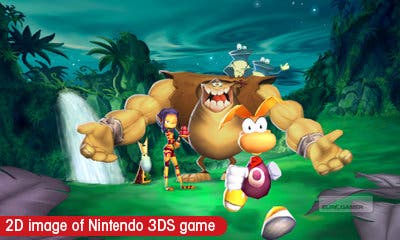Rayman 3D
Back to the future.
Ubisoft has been so busy porting Rayman 2, it's a wonder the publisher has any time left to spend on new Rayman games. Since 1999, this game has appeared everywhere – the N64 and Dreamcast, the PlayStation and PlayStation 2, the iPhone and iPad, PSN... And, most relevantly, the original DS.
Rayman 3D is the same game again, but in 3D. It seems a bit rich that this is not pointed out anywhere on the box or in the game itself. It does look a lot better than the 2005 DS iteration. It is purportedly sourced from Dreamcast version as opposed to the N64 game, and the circle pad makes controlling our hero a less torturous experience.
Other than that it's the same game again, relying on the endurance of 12 year-old mechanics and environment layouts.
The language of 3D game design has evolved much in the intervening time. In good modern platformers, clever camera framing guides the eye towards important object and areas. Use of colour or effects lead us subtly towards where we need to go.
(In bad ones, of course, we're led by the nose through boring levels along signposted routes that could hardly be more obvious, and must spend five minutes learning how to push forward on the stick.)
With its strange or absent signposting, unhelpful camera angles and odd, surreal palette, Rayman 3D speaks a dialect that's difficult to understand if you didn't learn it back in the day. It shows its age in ways that are actually quite interesting, and give you an insight into the direction design trends have taken over the past decade or so.

It's the surreal nature of the game which makes people remember Rayman 2 fondly. Captured by menacing robotic pirates, Rayman escapes a slave ship and must hunt through 19 levels for winged balls of light called Lums.
Mostly they're scattered around in plain sight, but some are fiendishly hidden. Others are imprisoned within cages, and their plaintive creaking and cries of 'Help!' will follow you around long after you switch the game off. Rayman 2 is as much about this obsessive quest for secreted Lums as about overcoming the platforming challenges of its large, strange levels.
Rayman is a satisfying character to control, falling somewhere between the acrobatic elegance of Mario and the versatility of Banjo and Kazooie. His world is unique. It features weird, slightly nightmarish characters and a bold, distorted colour scheme which relies heavily on purple and green. There are plenty of odd setpieces like riding around on a two-legged bomb, Dr Strangelove-style, or water-skiing on a swamp whilst hanging on for dear life to a runaway snake's scarf.
The jumping and climbing is broken up with puzzles where Rayman has to carry explosive barrels or orbs around tricky labyrinths to unlock doors. There are simple but satisfying fights against one-eyed robot pirates who shoot energy orbs from chunky guns.


